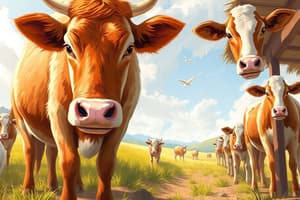Podcast
Questions and Answers
What is the primary focus of routine management in livestock production?
What is the primary focus of routine management in livestock production?
- Ensuring the welfare of animals under rearing (correct)
- Increasing market prices for livestock
- Minimizing feed costs for the farmer
- Maximizing the number of animals bred
Which livestock production system typically has the lowest level of input for animal care?
Which livestock production system typically has the lowest level of input for animal care?
- Extensive production system (correct)
- Semi-intensive production system
- Intensive production system
- Commercial production system
What is a critical component of feeding livestock?
What is a critical component of feeding livestock?
- Restricting food intake to keep costs down
- Relying solely on grazing without supplementation
- Ensuring adequate nutrition for growth and maintenance (correct)
- Providing only grain-based diets
In intensive livestock production, what is a significant risk associated with high stocking density?
In intensive livestock production, what is a significant risk associated with high stocking density?
Which of the following is NOT typically provided in a semi-intensive livestock production system?
Which of the following is NOT typically provided in a semi-intensive livestock production system?
What is an important consideration for the hygiene practices in livestock management?
What is an important consideration for the hygiene practices in livestock management?
Which of the following best describes the nutritional needs of livestock?
Which of the following best describes the nutritional needs of livestock?
What management practice can enhance the well-being of livestock in intensive systems?
What management practice can enhance the well-being of livestock in intensive systems?
What is the primary reason for debeaking birds early in their life?
What is the primary reason for debeaking birds early in their life?
What is the purpose of dehorning in animals?
What is the purpose of dehorning in animals?
Why is weighing animals considered an essential management practice?
Why is weighing animals considered an essential management practice?
What is the effect of castration on male animals?
What is the effect of castration on male animals?
What describes a disease in animals?
What describes a disease in animals?
What method is commonly used to estimate the weight of an animal when calibrated scales are unavailable?
What method is commonly used to estimate the weight of an animal when calibrated scales are unavailable?
Which of the following is a method used for dehorning animals?
Which of the following is a method used for dehorning animals?
What is a key implication of weight management in animals?
What is a key implication of weight management in animals?
What are the six classes of nutrients essential for animal health?
What are the six classes of nutrients essential for animal health?
Why is water considered essential for animals despite not being classified as a nutrient?
Why is water considered essential for animals despite not being classified as a nutrient?
What is the effect of deficient nutrition on animals?
What is the effect of deficient nutrition on animals?
Which of the following is true regarding roughages and concentrates?
Which of the following is true regarding roughages and concentrates?
Which practice is NOT included in maintaining good hygiene for animals?
Which practice is NOT included in maintaining good hygiene for animals?
How does proper stocking density affect animal welfare?
How does proper stocking density affect animal welfare?
What should be considered when determining the appropriate stocking density for animals?
What should be considered when determining the appropriate stocking density for animals?
Which factor increases a working animal's water requirement significantly?
Which factor increases a working animal's water requirement significantly?
Flashcards are hidden until you start studying
Study Notes
Livestock Production Systems
- There are three main production systems: extensive, semi-intensive, and intensive.
- Extensive systems have low inputs from farmers and animals are usually few.
- Semi-intensive systems have some farmer input, including housing and partial feeding.
- Intensive systems provide all inputs necessary for the animals, including housing, feeding, and medication.
Routine Management
- Routine management is a set of practices that ensure the welfare of livestock animals.
- Feeding is the adequate provision of feed with the necessary nutrients for an animal.
- Adequate nutrition provides energy for work and important bodily functions.
- Watering is essential for animals as it comprises up to 75% of their body weight.
- It is critical for digestion, blood circulation, waste removal, and regulating body temperature.
- Good hygiene is essential, including the removal of feces, urine, and other dirt.
- Proper stocking density is essential for efficient use of space and animal welfare.
- Considerations for stocking density include animal size, feeder space, drinker space, house dimensions, and nutrition.
- Debeaking is removing the beak to prevent injuries from pecking and fighting in birds.
- Disbudding and dehorning prevent injuries to animals and their handlers.
- Weighing is important for determining proper feed rations, administering medications, and tracking growth.
- Castration is the removal of parts of the male reproductive system, reducing testosterone and improving meat quality.
Diseases
- Diseases are disorders of structure or function that produce symptoms.
- Causes include infection, genetic defects, and environmental stress.
Studying That Suits You
Use AI to generate personalized quizzes and flashcards to suit your learning preferences.




